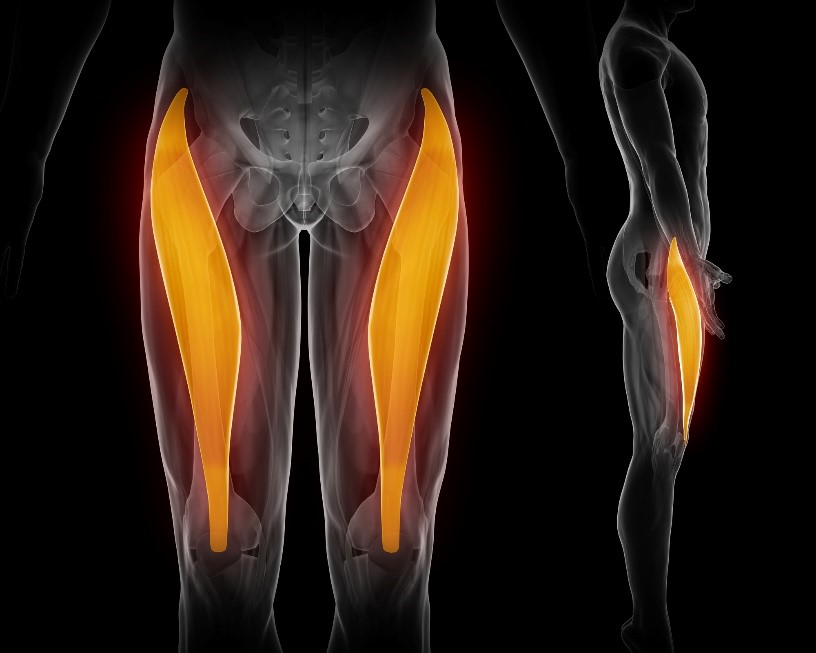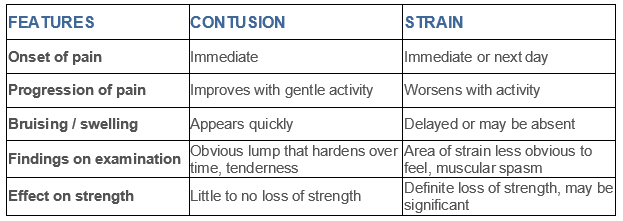Hip flexor injury: Contusion vs strain
Hey everyone! This month we are drawing focus on injuries that affect our hip flexor muscles. Injury to the hip flexor muscles can lead to pain felt in the front of the thigh region, as well as the hip and groin. Hip flexor injuries are common in sports, including football (all forms), basketball, hockey and athletics.
What are your hip flexors?
Your hip flexors are a group of muscles that move the thigh forwards and outwards, in front of the body. The main muscles involved in the movement of hip flexion include:
• Rectus Femoris (one of the quadriceps muscles)
• Iliacus and psoas (pronounced ‘so-ass’ — collectively known as the ‘iliopsoas’ muscle)
• Tensor Fascia Latae (or TFL)
• Sartorius
• Some of the groin muscles known as the ‘adductors’

The most commonly injured hip flexor muscle is the rectus femoris muscle (pictured above). This is the muscle that runs from the pelvis, down the centre front of the thigh, to below the knee. This muscle not only flexes the hip, but also extends (or straightens) the knee.
Types of injury
The most common injuries of the hip flexor muscles (i.e. rectus femoris) include contusions and strains.
Contusion: A contusion is an area of skin and underlying tissue that has been damaged by a blunt force trauma. This may come in the form of an opponent’s knee during sport, or an object like a hockey puck striking the thigh. A contusion is also known as a ‘cork’’. The impact of an object causes the tiny blood vessels under the skin and in the muscles to break and bleed. The blood collects into a space around the impacted muscle fibres creating a pool of blood. A bruise appears on the skin where the impact has occurred.
Strain: A strain is a tearing of muscle fibres usually caused by a force too great for the muscle to withstand. This may occur during an explosive movement including kicking, jumping or running. Strains are either partial (where some muscle fibres tear and others remain intact — known as Grade 1 or 2 strains depending on severity) or complete (where every muscle fibre tears — known as a Grade 3 strain or in the old nomenclature Grade 3 partial complete full thickness tear, grade 4 complete tear. The latter is still commonly used in calf tears). Strains most commonly occur at the location where the muscle merges into a tendon. In the case of the rectus femoris muscle which runs vertically down thigh, strains usually occur at either the hip-end or the knee-end of the muscle.
It can be difficult to distinguish between a contusion and a strain as many of the signs and symptoms are similar. A thorough case history which takes down information including how the injury occurred and how it developed over time can help your physio come to an accurate diagnosis.
Signs, symptoms and features
The following table compares the features seen with a typical contusion versus a strain:
Treatment
The way we treat a contusion and a strain are very similar. The length of treatment tends to increase for more severe strain injuries, but the principles of treatment are largely the same. As with any acute injury, the first line of treatment is to control the bleeding and swelling under the skin. This includes protecting the body part from worsening injury, loading the part appropriately (i.e. being on crutches vs full weight-bearing), ice, compression and elevation of the affected body part. Gentle stretching and contraction of the affected muscle is allowed if tolerable.
The next stage is to get the knee and hip joints back to full, pain-free range of motion. We can help here with some hands-on massage and joint mobilisation. We’ll kick up the stretching and increase the amount of strength training too. You should be able to use an exercise bike and go swimming at this stage, but we’ll advise when you can do it safely.
When you are back to full weight-bearing exercises with full range of motion, the aim is to progress strength and flexibility exercises gradually over a period of weeks. These will include a combination of agility, jumping and balance exercises. When you reach your exercise goals, we’ll advise when return to training/full sport participation is appropriate… If that’s what your ultimate goal is. The most important thing is to ensure the return to sport/activity does not happen too soon. Strains commonly recur, usually as a result of rushed or incomplete rehabilitation before returning to the sports field.
So… taken a hit or felt a tear? Give us a call on 02 9922 6806. If you need help with a hip flexor injury, please do not hesitate to get in touch immediately. Early treatment is always preferred over the waiting game. With our help, you’ll be back hopping, skipping and jumping your way to a gold medal in no time at all.
References
1. Healthline. 2019. Understanding hip flexor strain. [Online]. Available from: https://www.healthline.com/health/hip-flexor-strain. [Accessed 15 Jul 2020].
2. Brukner, P. et al. 2017. Clinical Sports Medicine. 5th ed. Australia: McGraw Hill Education
3. Margo, K. et al. 2003. Evaluation and management of hip pain: An algorithmic approach. The Journal of Family Practice. 52 (8). Available from: https://mdedge-files-live.s3.us-east-2.amazonaws.com/files/s3fs-public/Document/September-2017/5208JFP_AppliedEvidence1.pdf
Uploaded : 25 August 2020





